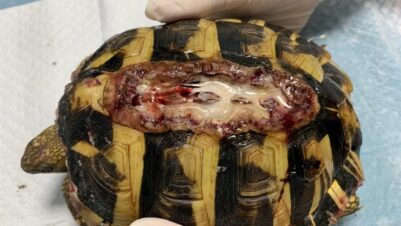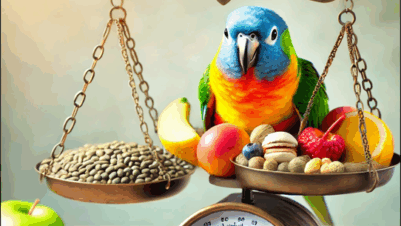Birds which are hospitalised often require supportive feeding as part of their treatment and recovery. Oral medications can similarly be given to patients by gavage, alongside a nutritional feed (Quesenberry and Hillyer, 1994). The ability to correctly handle and place the gavage tube while ensuring patient safety during such supportive feeding is important for a successful outcome.
Type of feeding tube
There are two main choices for crop feeding birds. The first is a curved or straight ball-tipped metal feeding tube, and the second is a red rubber feeding tube (Chitty and Monks, 2018). The metal tubes are most often used within a hospital setting, while the latter is more often seen within wildlife rehabilitation centres (Vriends, 1996). Metal crop tubes, if properly cleaned by flushing and scrubbing, are often the more hygienic choice as they can be soaked and autoclaved thereby preventing spread of disease from patient to patient.
The choice of tube, however, goes beyond hygiene reasons within the veterinary setting (Chitty and Monks, 2018). The stainless-steel tubes are most suitable for psittacine birds due to their strength – if a bird bites through the rubber tube it could be swallowed by the patient (Dawson and Whittow, 2000). Conversely, it is best to use rubber tubes for gavage in passerines as not only do they have a lower beak strength, but also the rubber tubes are more pliable which minimises risk of trauma occurring during crop feeding (Evans, 2007). If neither of the conventional tube types are available, then depending on the bird’s size, alternatives can be created utilising urinary catheters up to lamb feeding tubes.
Size of feeding tube
The width of the tube is important to ensure that it is neither too big to fit down the oesophagus, nor narrow enough to accidently slip into the bird’s trachea
Once the type of tube has been chosen, the correct size must be selected with the length of the tube being determined by the distance from the beak to the bird’s crop. The width of the tube is important to ensure that it is neither too big to fit down the oesophagus, nor narrow enough to accidently slip into the bird’s trachea (Dorrestein, 2000). The width of the tube can also determine the viscosity of the nutrition being provided. The author uses EmerAid most commonly as nutritional support for avian patients, and by following the correct ratios, this should allow the feed to be passed through most tube widths without altering the ratios. When making up the liquid feed, ensure that the temperature is not excessively hot to avoid crop burns. Further, make certain that when the syringe of feed is attached to the tube that the tube is flushed through to ensure no air is passed into the crop when feeding (Jenkins, 1997).
Calculating feed volumes
To identify the correct volume of feed to be given, the basal metabolic rate (BMR) should be calculated. The BMR of a patient is the kcal required over a 24-hour period:
BMR = K (weight (kg) 0.75)
K is a constant value defined by the order of birds that the patient belongs to. K = 129 in passerines and K = 78 in psittacines (Samour, 2016).
Once the calculation for BMR has been made then the status of the patient can be further taken into consideration, eg BMR x 1.25 for a hospitalised patient. This number can then be divided by the kcal content of the nutritional support given and then subdivided into quantity of feeds over the day (Samour, 2016). A crop volume which is deemed safe for a patient should be around 3 to 5 percent of the patient’s body weight (Chitty and Monks, 2018).
Placing the gavage
When handling the bird, it is important to ensure that no excessive pressure is placed onto the bird’s keel, as due to their lack of diaphragm this will cause issues with their breathing and cause the bird to panic. Use an appropriately sized towel to secure the bird safely overall and ensure that the bird’s body is placed into the palm of the handler (Figure 1). Ensuring that the bird’s wings are secured will safeguard against the risk of wing damage during handling, and securing the head will prevent risk to bird and handler. When ready, the bird’s neck should be gently extended to assist with the tube placement and passage down the oesophagus (Denbow, 2000).


Starting from the handler’s right, place the tube from the corner of the beak then pass the tube over the tongue and down the oesophagus (Figure 2) (Denbow, 2000). When sliding the crop tube down, ensure that it does not enter the trachea or damage the choana. Gently flex the crop tube forward and check positioning by visually and physically checking that the distal tip of the tube is at the level of the thoracic inlet (Evans, 2007).
Regurgitation is one of the most common risks seen in crop feeding and how we respond can have a severe impact upon the outcome of such an event
Once the placement of the tube has been confirmed, gently plunge the syringe and monitor the patient visually to ensure that the crop is not becoming overfull, with contents potentially leaking into the trachea. Regurgitation is one of the most common risks seen in crop feeding and how we respond can have a severe impact upon the outcome of such an event. If the bird begins to struggle or regurgitate, then immediately remove the tube and place the patient back within the kennel to allow them to flick the food out of their mouth. If the bird is too weak or unable to clear the contents itself, then suction can be considered (Chitty and Monks, 2018).
Final thoughts
Despite all the positives of gavage feeding patients, the process does come with risks and there are contraindications for its use. Situations where crop feeding is likely not appropriate include crop stasis or full thickness crop burns, as well as cases of impaction within the gastrointestinal tract.
Gavage feeding into the crop is an integral way of providing nutritional support and medications to patients. By ensuring the proper preparation steps are followed, the veterinary team can minimise the risk of adverse incidents that can arise from crop feeding patients.











